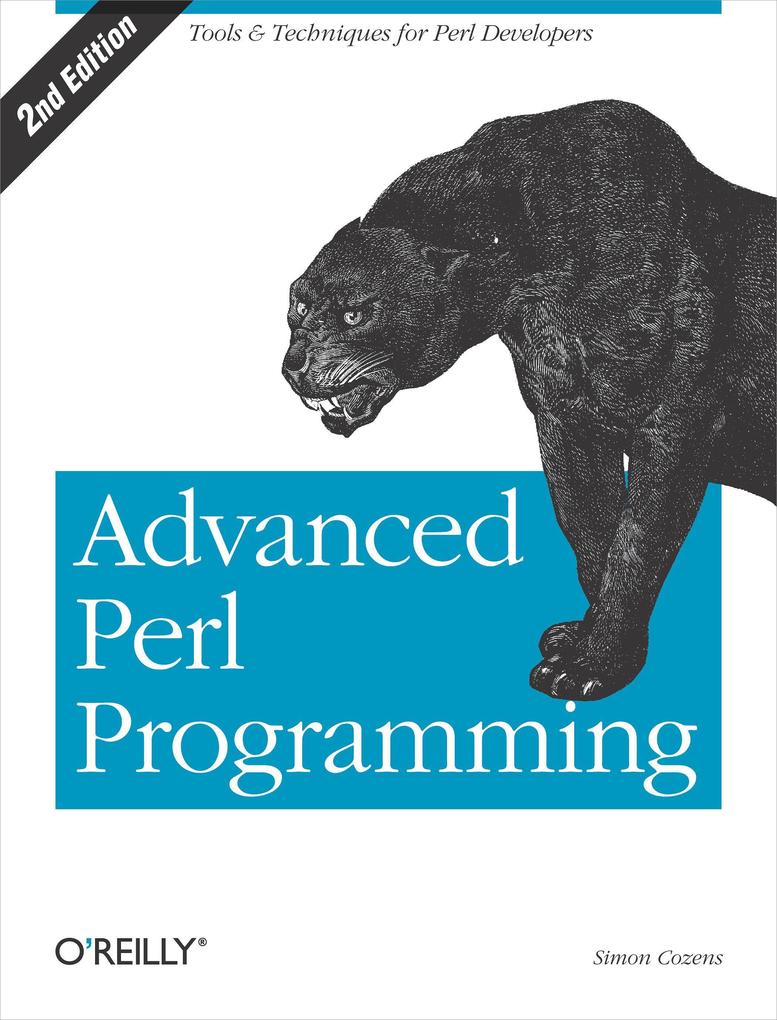
Zustellung: Mo, 28.07. - Fr, 01.08.
Versand in 2 Wochen
VersandkostenfreiBestellen & in Filiale abholen:
With a worldwide community of users and more than a million dedicated programmers, Perl has proven to be the most effective language for the latest trends in computing and business. Every programmer must keep up with the latest tools and techniques. This updated version of Advanced Perl Programming from gives you the essential knowledge of the modern Perl programmer. Whatever your current level of Perl expertise, this book will help you push your skills to the next level and become a more accomplished programmer.
This edition teaches you all the complex techniques for production-ready Perl programs. This completely updated guide clearly explains concepts such as introspection, overriding built-ins, extending Perl's object-oriented model, and testing your code for greater stability. Other topics include: Complex data structures, Parsing Templating toolkits, Working with natural language data, Unicode Interaction with C and other languages. In addition, this guide demystifies once complex topics like object-relational mapping and event-based development-arming you with everything you need to completely upgrade your skills.
This edition teaches you all the complex techniques for production-ready Perl programs. This completely updated guide clearly explains concepts such as introspection, overriding built-ins, extending Perl's object-oriented model, and testing your code for greater stability. Other topics include: Complex data structures, Parsing Templating toolkits, Working with natural language data, Unicode Interaction with C and other languages. In addition, this guide demystifies once complex topics like object-relational mapping and event-based development-arming you with everything you need to completely upgrade your skills.
Inhaltsverzeichnis
Preface;
Audience;
Contents;
Conventions Used in This Book;
Using Code Examples;
We'd Like to Hear from You;
Safari® Enabled;
Acknowledgments;
Chapter 1: Advanced Techniques;
1. 1 Introspection;
1. 2 Messing with the Class Model;
1. 3 Unexpected Code;
1. 4 Conclusion;
Chapter 2: Parsing Techniques;
2. 1 Parse::RecDescent Grammars;
2. 2 Parse::Yapp;
2. 3 Other Parsing Techniques;
2. 4 Conclusion;
Chapter 3: Templating Tools;
3. 1 Formats and Text::Autoformat;
3. 2 Text::Template;
3. 3 HTML::Template;
3. 4 HTML::Mason;
3. 5 Template Toolkit;
3. 6 AxKit;
3. 7 Conclusion;
Chapter 4: Objects, Databases, and Applications;
4. 1 Beyond Flat Files;
4. 2 Object Serialization;
4. 3 Object Databases;
4. 4 Database Abstraction;
4. 5 Practical Uses in Web Applications;
4. 6 Conclusion;
Chapter 5: Natural Language Tools;
5. 1 Perl and Natural Languages;
5. 2 Handling English Text;
5. 3 Modules for Parsing English;
5. 4 Categorization and Extraction;
5. 5 Conclusion;
Chapter 6: Perl and Unicode;
6. 1 Terminology;
6. 2 What Is Unicode? ;
6. 3 Unicode Transformation Formats;
6. 4 Handling UTF-8 Data;
6. 5 Encode;
6. 6 Unicode for XS Authors;
6. 7 Conclusion;
Chapter 7: POE;
7. 1 Programming in an Event-Driven Environment;
7. 2 Top-Level Pieces: Components;
7. 3 Conclusion;
Chapter 8: Testing;
8. 1 Test::Simple;
8. 2 Test::More;
8. 3 Test::Harness;
8. 4 Test::Builder;
8. 5 Test::Builder::Tester;
8. 6 Keeping Tests and Code Together;
8. 7 Unit Tests;
8. 8 Conclusion;
Chapter 9: Inline Extensions;
9. 1 Simple Inline::C;
9. 2 More Complex Tasks with Inline::C;
9. 3 Inline:: Everything Else;
9. 4 Conclusion;
Chapter 10: Fun with Perl;
10. 1 Obfuscation;
10. 2 Just Another Perl Hacker;
10. 3 Perl Golf;
10. 4 Perl Poetry;
10. 5 Acme::*;
10. 6 Conclusion;
Colophon;
Audience;
Contents;
Conventions Used in This Book;
Using Code Examples;
We'd Like to Hear from You;
Safari® Enabled;
Acknowledgments;
Chapter 1: Advanced Techniques;
1. 1 Introspection;
1. 2 Messing with the Class Model;
1. 3 Unexpected Code;
1. 4 Conclusion;
Chapter 2: Parsing Techniques;
2. 1 Parse::RecDescent Grammars;
2. 2 Parse::Yapp;
2. 3 Other Parsing Techniques;
2. 4 Conclusion;
Chapter 3: Templating Tools;
3. 1 Formats and Text::Autoformat;
3. 2 Text::Template;
3. 3 HTML::Template;
3. 4 HTML::Mason;
3. 5 Template Toolkit;
3. 6 AxKit;
3. 7 Conclusion;
Chapter 4: Objects, Databases, and Applications;
4. 1 Beyond Flat Files;
4. 2 Object Serialization;
4. 3 Object Databases;
4. 4 Database Abstraction;
4. 5 Practical Uses in Web Applications;
4. 6 Conclusion;
Chapter 5: Natural Language Tools;
5. 1 Perl and Natural Languages;
5. 2 Handling English Text;
5. 3 Modules for Parsing English;
5. 4 Categorization and Extraction;
5. 5 Conclusion;
Chapter 6: Perl and Unicode;
6. 1 Terminology;
6. 2 What Is Unicode? ;
6. 3 Unicode Transformation Formats;
6. 4 Handling UTF-8 Data;
6. 5 Encode;
6. 6 Unicode for XS Authors;
6. 7 Conclusion;
Chapter 7: POE;
7. 1 Programming in an Event-Driven Environment;
7. 2 Top-Level Pieces: Components;
7. 3 Conclusion;
Chapter 8: Testing;
8. 1 Test::Simple;
8. 2 Test::More;
8. 3 Test::Harness;
8. 4 Test::Builder;
8. 5 Test::Builder::Tester;
8. 6 Keeping Tests and Code Together;
8. 7 Unit Tests;
8. 8 Conclusion;
Chapter 9: Inline Extensions;
9. 1 Simple Inline::C;
9. 2 More Complex Tasks with Inline::C;
9. 3 Inline:: Everything Else;
9. 4 Conclusion;
Chapter 10: Fun with Perl;
10. 1 Obfuscation;
10. 2 Just Another Perl Hacker;
10. 3 Perl Golf;
10. 4 Perl Poetry;
10. 5 Acme::*;
10. 6 Conclusion;
Colophon;
Produktdetails
Erscheinungsdatum
02. August 2005
Sprache
englisch
Auflage
2nd edition
Seitenanzahl
298
Autor/Autorin
Simon Cozens
Verlag/Hersteller
Produktart
kartoniert
Gewicht
499 g
Größe (L/B/H)
229/181/18 mm
ISBN
9780596004569
Entdecken Sie mehr
Bewertungen
0 Bewertungen
Es wurden noch keine Bewertungen abgegeben. Schreiben Sie die erste Bewertung zu "Advanced Perl Programming" und helfen Sie damit anderen bei der Kaufentscheidung.









